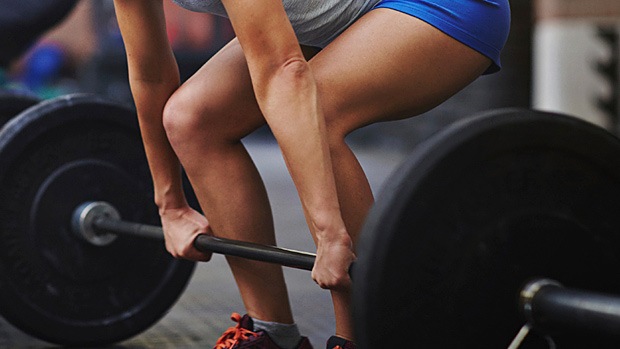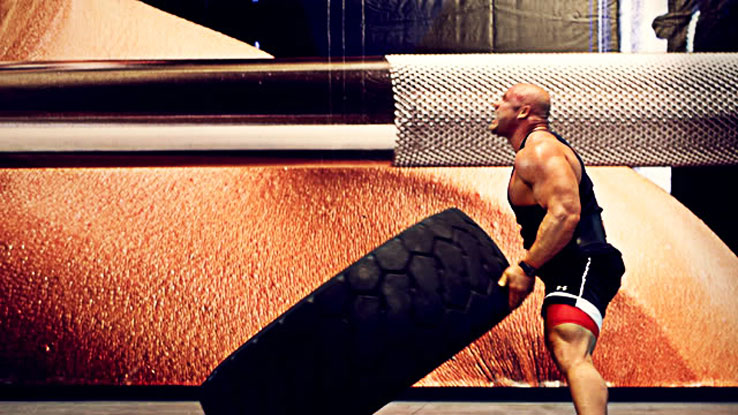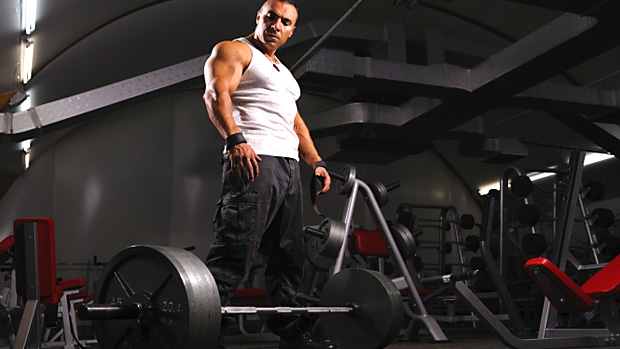Here's what you need to know...
- Pinning the scapulae back puts the shoulder into misalignment. "Wrap" the shoulder blades instead.
- Looking up when you squat limits neural drive. Stop it, then pack your neck.
- Grabbing the floor with your feet reduces lower body strength. Turn your feet out instead.
- Always keep a tight grip on the bar, not just during heavy lifts.
It's time to destroy myths and accelerate progress.
You may think these four myths – and their subsequent destruction – are for exercise physiology nerds only, but they have applications for everybody.
But before we go on, I have to provide one brief definition that gives context to the myths we're about to debunk.
Joint Centration
Joint centration means the best alignment for a joint to optimally support the body, along with proper length-tension relationships of the supporting musculature. The result is optimal interplay of the neuromuscular system.
In others words, it means more strength and better performance. Just keep that in mind as we get geeky here.
1 – Pin the Scaps
For a not-so-brief period of time I was the shoulder-blade Nazi. I'd even yell at strangers, "You there! Shoulders back and down and step lively!" It was a serious problem – not just because shouting commands at strangers doesn't win friends – but because I was wrong.
No More Blade Pinning?
What happens when we pin the shoulder blades back and down? Excessive adduction and downward rotation of the scapulae. Why is this bad? The simple answer is that it de-centrates the rest of the shoulder.
The humeral head can't translate posteriorly, so it's forced to move anteriorly – you'll have loads of stability, but misalignment promotes shitty movement and diminished strength.
Think also about what happens to the thoracic spine as the shoulder blades are crammed back and down – it's locked in place. Sure, we need upper-back stability for big movements, but not at the expense of mobility.
Squatting provides a strong visual of this concept. As a lifter descends toward the bottom position, the T-spine must extend so that all the joints below it align well to properly distribute the load. Align joints poorly and your strength suffers.
For a tangible shoulder centration experience before applying it to other lifts, set up for a snatch-grip deadlift. The elbows align at a forty-five degree angle, the bar is "broken" and the lats are tightened. The shoulder blades are stout – they're not protracted or retracted, nor are they upwardly or downwardly rotated. They hold place just where they should.
The Big Back Solution
I'll offer a cue: wrap the shoulder blades around the rib cage. This cue promotes stability while recruiting the peri-scapular muscles in good balance. Here's what it looks like.
The first picture is the result of the outdated pinning cue:

Now here's a pic of the wrapping technique:

Notice how much fuller the back looks with the wrapping cue? On the other hand, everything is smashed together when the scapulae are pinned.
To accompany this generic cue, here are specific cues as they apply to the big three lifts.
- Bench cues: Break the bar, big back.
- Squat cues: Elbows under the bar, squeeze tight, big back.
- Deadlift cues: Break the bar, long spine.
2 – Bull the Neck, Look to the Heavens
On a wall, above the TV, one of my defensive teammates proudly displayed a squat poster. Above a brutish, shirtless man the phrase "Bull your neck, send your eyes to Jesus and squat," was printed in bold, white letters.
It was a decent looking poster, appropriate for a college football player's dorm room, and its directions were congruent with everything I'd learned about lifting to that point. Putting the advice into action, however, never felt right.
My balance felt askew, I couldn't breathe well, and I never felt like my legs were in the right place – I'd always end up making a squat a good morning. I was jamming a fork in the circuitry.
Stop Looking Above for Help
Let's start by keeping something important in mind – the majority of the cervical spine is designed/adapted for stability. Most of the mobility is in the first two vertebrae, not the inferior five. Creating false stability by jamming the articular structures of the spine together de-centrates the cervical spine and reflexively inhibits the muscles of the inner core (diaphragm, pelvic floor, multifidi, transverse abdominus).
If these muscles don't fire first, the recruitment of the outer-core (abdominals, spinal erectors, glutes, lats) is skewed and a neurological inhibition cascade follows. Long story short, with your neck extended your brain thinks your spine isn't stable, or safe, and it limits neural drive to outer-core and prime movers.
Proponents of cervical extension while lifting are confused. Some think avoiding extension is about preventing a neck injury. Nope. Others hail the benefits of reflexive lumbar erector recruitment. No again.
Lumbar hyperextension – the result of cervical extension and the reflexive lumbar erector recruitment – limits neural drive to the glutes and synergistic hip extensor. That's a bad thing.
What we want, what we need, is reflexive recruitment of the inner-core – it removes the governor that restricts gas flow into the carburetor. This only happens optimally when the neck is in the packed, neutral position.
The Solution
Have a gander at the pictures below. Top is wrong, bottom is correct. Use this example to adjust your behavior accordingly for all lifts.


Follow the packed neck position up with a solid diaphragmatic breath and you're prepared to be a monster.
3 – Grab the Floor with Your Feet
My boss at the first strength and conditioning facility I worked at cued athletes to grab the floor with their feet. It sounded cool – and seemed to make sense – so I went with it. Too bad it didn't pan out in practice.
Somewhere along the line the co-contraction (irradiation) properties of a solidly set grip were mistakenly applied to the foot. It's like mistaking Icy Hot for hemorrhoid cream – a good thing is applied in the wrong place.
No More Eagle Claws?
Grabbing the floor feels like it promotes lower-body tension, but it's a faade. In truth, it disrupts lower-body movement and strength. Reflexive recruitment, however, is a recurring theme of our myth destruction and it continues with our body's grounding appendage.
Between the foot bones are muscles called interossei. When the foot spreads, these muscles contract, reflexively recruiting the posterior chain. If the foot is scrunched into the "grabbing" position, we lose this powerful strength promoting function.
The foot also finds its greatest stability while resting on a triangle made by the first metatarsalphalangeal joint, fifth metatarsalphalangeal joint, and the calcaneous (heel). Foot grabbing reduces the triangle's base of support, limiting foot stability and also limiting torque-based hip centration.
Hip centration is important for strength no matter the lift. For a practical example, watch what happens as any good Olympic lifter begins their pull from the ground – feet dial out, knees push out, hips externally rotate. That's hip centration resulting from a solid foot strategy.
The Solution
Externally rotate your feet slightly – for most people thirty degrees does the trick – and screw your feet into the ground. This is also called "dialing your feet out." You'll feel your glutes and hip external rotators contract instantly. Check out the video example below:
4 – High-Tension is Only for Heavy Loads
It's well-known that heavy loads increase muscular tension. If they didn't, the loads wouldn't move. It's a misnomer, however, that the high muscular tension is only necessary with heavy loads. That dog just won't hunt.
Tension All The Time?
The short answer is yes. Strength and athleticism are based on neurological output. This requires maximizing neurological output every time we put a weight in our hands. Optimal joint centration combined with optimal tension generation creates the optimal feedback loop between our afferent (sensory) and efferent (motor) nervous systems.
This means your body has a better sense of where it's aligned and frees your brain for serious force and power. This input and output loop transfers to all activities based on strength and athleticism.
The Solution
Irradiation is the concept of grabbing onto a bar as hard as you can so that the nervous system gets more muscles involved. Use it to your advantage at all times. No matter the load, create as much tension as possible. Grip every bar as if you're crushing a bear's throat; squeeze your lats as if they're the link between you and sudden death. Move all weights with murderous intent.
It's About Training Optimally
I know the game, and I know what's about to happen. Examples from Konstantin Konstantinovs' videos get thrown around, clearly demonstrating his rounded back and extended neck while deadlifting. We'll read and hear the stories about some very strong guy at an underground gym that deplores this article's advice and squats 700.
But none of us are Konstantin – he's an anomaly. Other examples must be thrown into the "in spite of" category, rather than that of examples worth following.
Look, if you're making a PR attempt, then go get the damn PR. Everything isn't always going to be perfect. But that's no excuse to train that way. Perpetual poor alignment leads to poor recruitment – your brain will put on the breaks one way or another, either by limiting force output or by a small injury to prevent a larger one.
True and lasting strength is built when the body is put in the best positions possible and trained to move in and out of these positions violently.
Conclusion
The body doesn't know the meaning of myth. It doesn't know the difference between right and wrong. What it knows is repetition and adaptation. That's why centration and neutrality are so important – training optimally produces greater gains over longer, less injurious, training careers.
Ditch the myths and make progress.





